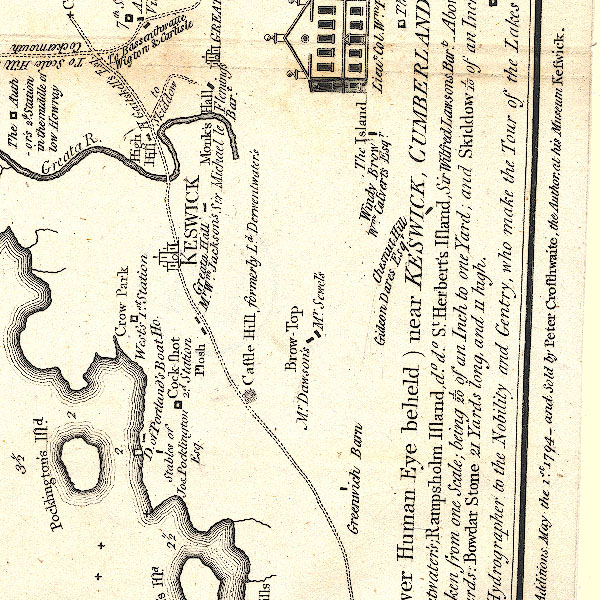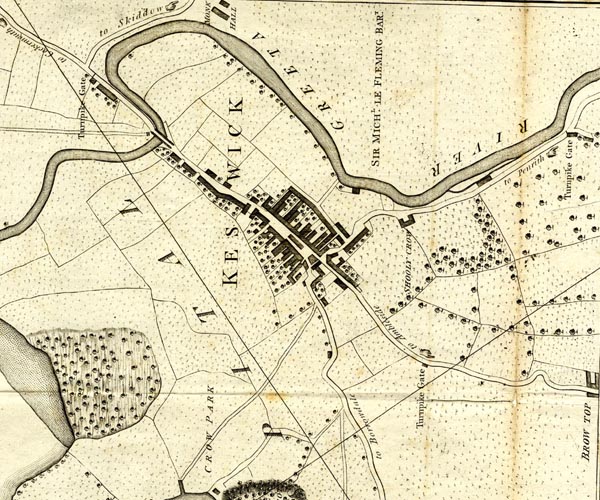




placename:- Crow Park
item:- oak
 goto source
goto sourcePage 88:- "... Crow-park, which formerly contained a grove of oaks of immemorial growth, whose fall the bard of Lowes-water thus bemoans, in humble plaintive numbers:"
"- That ancient wood where beasts did safely rest, / And where the crow long time had built her nest, / Now falls a destin'd prey to savage hands, / Being doom'd, alas! to visit distant lands. / Ah! what avails they boasted strength at last! / That brav'd the rage of many a furious blast; / When now the body's spent with many a wound, / Load groans its last, and thunders on the ground, / While hills, and dales, and woods, and rocks resound,"
"This now shadeless pasture, is a gentle eminence, not too high, on the very margin [of the lake Derwent Water] ..."
"..."
 goto source
goto sourcePage 89:- "... Mr. Gray speaks thus,- 'October 4, I walked to Crow-park, now a rough pasture, once a glade of ancient oaks, whose large roots still remain in the ground, but nothing has sprung from them. If one single tree had remained, this would have been an unparalleled spot; ...'"
 goto source
goto sourcePage 90, footnote:- "As one province of the Guide, is to point out the characteristic features, and distinguished parts of this lake, in order to exhibit the best landscape picture to the artist, and to give the most pleasure and entertainment to the company who make the tour, the author has taken all possible care to secure these ends in his choice of stations. Yet, there is one impediment attends his descriptions, which will, in part, prevent their permanency, and that is, the annual fall of timber and coppice wood, and the frequent removal of the picturesque trees which take place on the borders of the lakes. These accidents, however, as they cannot be prevented, must be allowed for by the candid traveller, where he finds the original differing in these respects from the account given of it in the book."
"The fall of Crow park, on Derwent-water, has long been regretted. And Mr. Gray's beautiful description of Foe-park, above mentioned, is not now to be verified."
"It is true that the painter, by the creative power of his pencil, can supply such deficiencies in the features of his landscape, but the plastic power of nature, or the careful hand of industry, directed by taste and judgement, can only make up such losses to the visitors of the lakes."
"Thus much was thought proper to be subjoined in this place, as an apology, once for all, for the casual differences of this kind, that may be found between the descriptions given of these lakes in this manual, and their real appearance at any future time."
 goto source
goto sourceAddendum; Mr Gray's Journal, 1769
Page 206:- "..."
"In the evening I walked alone down to the lake, by the side of Crow-park, after sun-set, and saw the solemn colouring of the night draw on, the last gleam of sun-shine fading away on the hill tops, the deep serene of the waters, and the long shadows of the mountains thrown across them, till they nearly touched the hithermost shore. At a distance were heard the murmurs of many water-falls, not audible in the day time; I wished for the moon, but she was dark to me, and silent,"
"Hid in her vacant interlunar cave."
"Oct. 4. I walked to Crow-park, now a rough pasture, once a glade of ancient oaks, whose large roots still remain in the ground, but nothing has sprung from them. If one single tree had remained, this would have been an unparalleled spot: and Smith judged right when he took his print of the lake from hence, for it is a gentle eminence, not too high, on the very margin of the water, and commanding it from end to end, looking full into the gorge of Borrowdale. ..."
placename:- Crow Park

CT2NY22Q.jpg
"Crow Park / West's 1st. Station"
item:- Armitt Library : 1959.191.3
Image © see bottom of page
item:- oak; tree
 goto source
goto sourcePage 63:- "..."
"The road to the Lake lies by Crow-Park, (see plate VI.) which was covered with wood thirty-five years ago: the trees were all oak, about 17 yards high, of a most proportionable thickness, and so equal in height, that when in full leaf their tops appeared as close and smooth as a bowling-green: so close indeed did they grow, that many persons now alive have gone from one side of the wood to the other among the branches of the trees without ever coming to the ground. This, with the wood upon Lord's Island, and several other places, was sold by the governors of Greenwich Hospital, A.D. 1749, to a Mr Marthas, or Mathews, of Greenwich, for 7000 pounds: It was advertised to be sold in London by inch of candle; but these trusty guardians of public treasure, the governors, contrived to exclude every bidder, except their minion Mr Mathews above mentioned; thus this valuable wood was almost literally given away. The purchaser had ten years allowed to cut down the timber; and accordingly employed one Joseph Dawson to cut it for him. Dawson begun his work on the 1st of May 1749, and before the end of the year returned to his employer L.1800 clear; the second year he returned nearly the same sum; he then sold the remainder to the merchants at Whitehaven, but the sum it sold for has always been kept a profound secret. It is worthy of remark, that the merchants of Whitehaven thought themselves so injured by the manner in which Mathew's purchase was smuggled to him, that they brought their action against the governors of the Hospital, but were nonsuited."
 goto source
goto sourcePage 64:- "After the wood was cut, none of the trees appearing likely to sprout again, the farmer, Mr Scott, dug them all up and ploughed the ground. His manner of ploughing it deserves notice; he begun at the base of the hill, and ploughed in a spiral to the top, so that one ridge and one furrow covers the whole space. ..."
placename:- Crow Park

CL152623.jpg
"CROW PARK"
area
item:- private collection : 169
Image © see bottom of page
item:- trees; oak; fir
 goto source
goto sourceGentleman's Magazine 1805 p.1122 "..."
"In the evening of the 22d we sauntered through a delicious grove of oak and fir, crowning an eminence which overhangs the West border of the Lake; in our way, we learned with regret, that the Dryads of Crow Park were no more; the greater part of the land here is annexed to the estates of public charities or private manors; and it is indeed a subject of deep and universal regret to the lovers of Lake scenery, that the coppice wood and forestries should be so often and so barbarously mutilated, and the shores denuded of their fine foliage trimmings, by the avarice or caprice of their tasteless owners:"
"Sed non omnes arbusta juvant."
placename:- Crow Park
item:- oak; tree felling
 goto source
goto sourcepage 60:- "..."
"Crow Park was, within the recollection of some people, covered with ancient oaks; now there are none."
"Depredations of this sort are perpetually making upon the domains of taste; sometimes by the rich, and sometimes by their agents, in complete ignorance of the intrinsic value of such property. - Inclosed groups of trees planted in proper situations would restore the beauties of which this country has been thoughtlessly deprived; and the sons and daughters"
page 61:- "of the present generation would reap the benefits of such an improvement."
"The end of all human pursuits is to procure to every individual the greatest quantity of that kind of happiness he is capable of enjoying: men with minds devoid of cultivation, frequently place their affections exclusively on the accumulation of wealth, and are seldom inclined so to educate their children as to render them capable of rationally enjoying that wealth when it devolves to them. In the opinion of such men, there is no security for the preservation of their property, but in their children being trained in the industrious habits of their fathers, and thus is insensibility to the objects of taste perpetuated."
"Where refinement with honourable feeling and riches unite, every thing may be expected. A human being thus advantageously gifted, whatever may be his peculiar pursuit in life, will"
 goto source
goto sourcepage 62:- "always be influenced by a disposition to contribute to the perfection of that taste which he knows is the last and highest ornament of the temple of talents and virtue."
"The view from Crow Park is into Borrowdale."
"..."
item:- oak; tree; races
 goto source
goto sourcePage 120:- "... Crow Park, which at the time of the attainder of the late Earl of Derwentwater, was a wood of stately oaks; but is now a fine, swelling, verdant field, on which races are annually held. ..."
